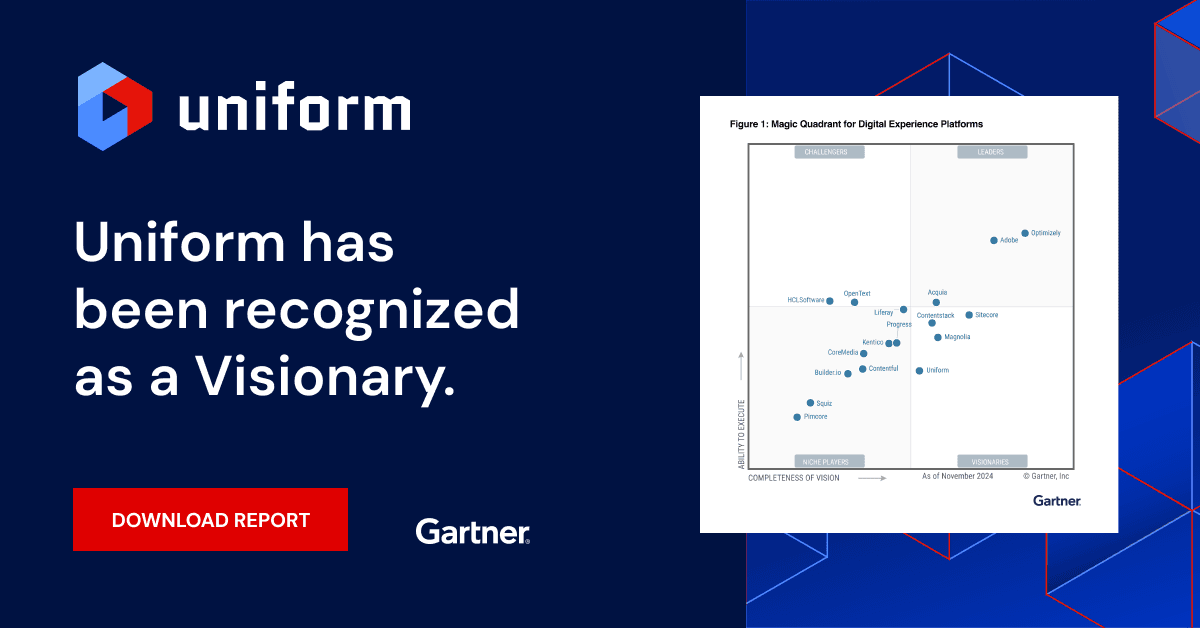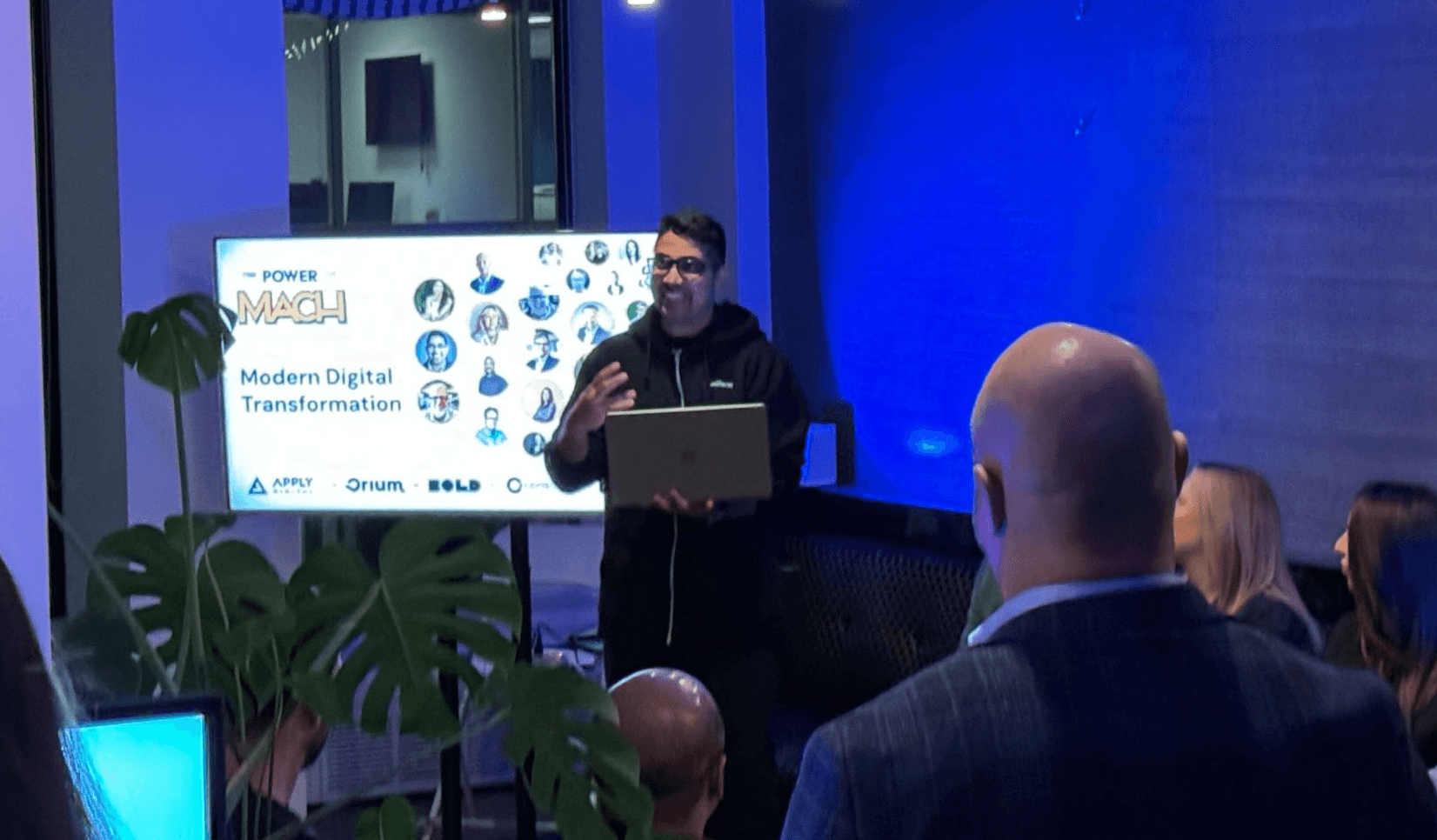Uniform blog/Visual workspace vs. DXP: What’s the difference?
Visual workspace vs. DXP: What’s the difference?
Visual workspace vs. DXP: What’s the difference?
In an evolving landscape of heightened competition, tight budgets, and endless vendor options, is a digital experience platform (DXP) the right solution for owning the web and mobile experiences of major brands? Or would a visual workspace, with organization-wide integration flexibility and a no-code path to market, be better suited to create and deliver enterprise omnichannel experiences?
Let’s examine where the DXP and the Visual Workspace align and how they differ in omnichannel experience management.
What’s a DXP?
DXPs have been around for well over a decade and remain a popular choice for organizations seeking to optimize digital experiences on the web and beyond.
Gartner states that “A DXP is an integrated set of technologies designed for the composition, management, delivery, and optimization of personalized digital experiences across multiple channels in the customer journey.” These built-in capabilities—content management, SEO, digital asset management (DAM), and others—are a big draw if you’re looking for an all-in-one system that can provide most, if not all, of the functionality for omnichannel delivery.
At the surface, dealing with one vendor for ongoing support and maintenance is convenient. However, a DXP’s technological inflexibility presents obstacles when adding needed marketing tools or upgrading adjacent backend systems.
In a fast-moving market that thrives on speed and agility, DXPs’ “good enough for most approach” comes with drawbacks:
- Limited flexibility. Though some DXPs market themselves as composable, they’re still single-vendor solutions that lock businesses into one way of doing things at the expense of agility and flexibility. They're not true composable DXPs.
- Barriers to modernization. Once heavily invested in a single platform, adding tools is expensive and time-consuming, often taking months or even years to implement.
- Content-first framework. While these systems have the tools to create and manage digital experiences, they are built on top of a CMS. Therefore, how and what you create is filtered through this lens. Content is created first, then the experiences.
To deliver fast omnichannel experiences, enterprises need a platform that helps them move through workflows quickly and create enterprise content at scale from multiple sources, including systems beyond the DXP. A visual workspace, which has the same goals as a DXP, achieves this—but with a few key differences.
What’s a visual workspace?
If a DXP is a walled garden (a closed system that doesn't play well with external tools and platforms), the visual workspace is an open solution that supports an organization’s freedom to employ the tools it prefers to build powerful customer experiences.
DXP approach is "we have the best tools for everyone." Visual workspace approach is "what's best for one org isn't necessarily the best for another."
A visual workspace is the evolution of the single-source DXP into a presentation layer experience platform that aggregates tools and content regardless of their source. This empowers digital teams to craft digital experiences using any tool from any vendor without developers writing code to support it.
- Tech-agnostic. A visual workspace helps to future-proof a brand's digital experience tech stack by enabling it to integrate the tools it chooses–modern, legacy, and bespoke systems–without the heavy cost of integration or replatforming.
- Multi-source. With a visual workspace, marketers work with multiple sources from within the same platform to build and publish experiences across any channel, using content from any source, with go-to-market technology that caters to the brand’s unique customers.
- Experience-first. In a visual workspace, the brand experience guides the content creation and delivery process–as opposed to content in the CMS defining experiences–unlocking limitless opportunity to creativity delight customers and drive business.
In a visual workspace, creators can leverage any system in their digital experience tech stack, enabling them to create more engaging and relevant experiences. It solves the challenges of custom integration by making it a configuration task instead of a development task. It enables brands to adopt new technologies on their own terms, incrementally or all at once, without disrupting business.
Marketers have the freedom to create content using cutting-edge technologies without disrupting business.
Why choose a visual workspace for omnichannel delivery?
The era of using one DXP to manage digital content is coming to an end. The reality is that enterprises rely on several systems to build and publish experiences. A recent study showed that 67 percent of companies use multiple CMSs as part of their omnichannel strategy.
When a brand outgrows its DXP, it will need to replatform to another solution–an expensive and time-consuming exercise that brings a brand no business value while disrupting the daily work of digital teams responsible for getting campaigns up and running.
In contrast, a visual workspace–as the nexus of the go-to-market tech stack–offers 3 distinct advantages:
- Integration makes it stronger. Integrations are first-class citizens instead of passive participants in the visual workspace. With numerous technologies driving the omnichannel creation process, the result is better targeted, more engaging customer experiences.
- It accelerates speed to market. In a DXP, you rely on developers for upgraded features and functionality, a workflow that adds unnecessary steps to the digital production process. A visual workspace frees developers from writing integration or data access code, letting them focus on new components and business logic, while empowering marketers to control campaigns through publishing them independently.
- It exists to future-proof. If a brand outgrows its DXP, replatforming isn’t the only option. A visual workspace will integrate seamlessly with the current tech stack, from legacy systems to headless technologies, which means marketers can spend more time creating and less time waiting, and developers can spend more time innovating and less time upgrading.
Ultimately, the visual workspace offers the advantages of a DXP without its disadvantages: the power of native marketing tools and capabilities, while supporting the full technology investment now and in the future.
Unify your tech stack with Uniform
More than a decade after DXPs appeared on the market, the search for a solution that satisfies the demands of modern organizations continues. Along the path to omnichannel success, brands need a digital experience management solution that enables them to focus on building the most relevant and engaging experiences for their customers, without the battle to make all the different required technologies work together.
The Uniform Visual Workspace is an evolution beyond the limitations of DXPs, enabling digital teams to create experiences visually, quickly, and reliably from any content and data source. Request a demo to learn how the visual workspace can help you control your omnichannel experience management process using industry-leading technology.





.png&w=1080&q=90)
.png&w=1080&q=90)
